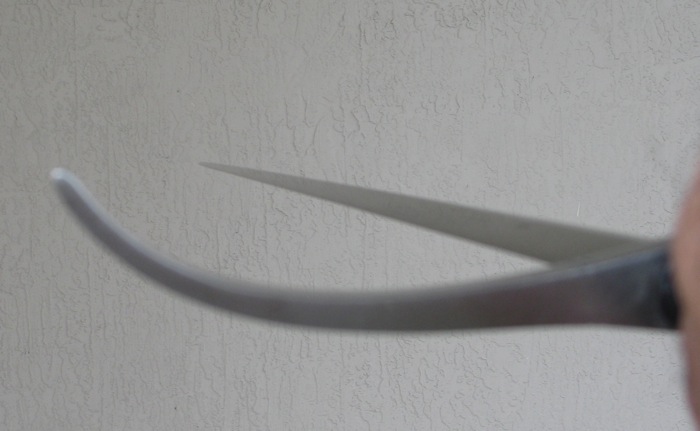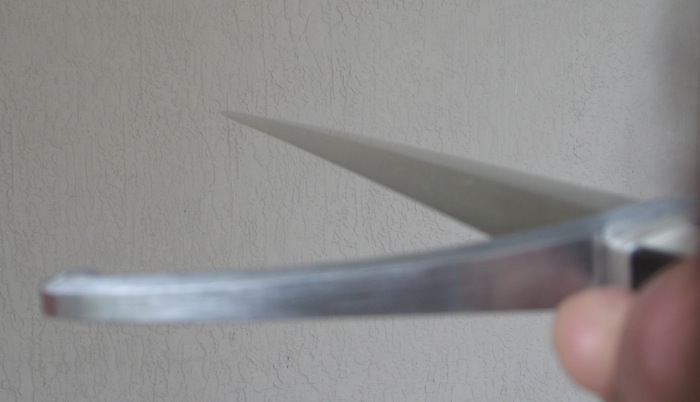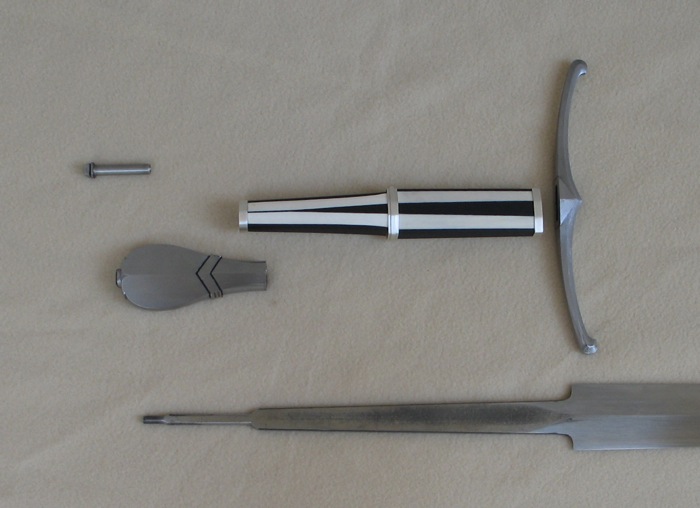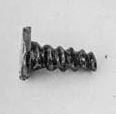| Author |
Message |
G. Ghazarian
Industry Professional

|
 Posted: Tue 23 Jun, 2009 6:06 pm Post subject: Posted: Tue 23 Jun, 2009 6:06 pm Post subject: |
 |
|
Hello Michael. thanks for you compliments.
Trying to answer your question, I attached below two pictures showing the deflection of Albion Munich blade and mine, both type XVIIIb and having a required rigid blade.
Considering the size of both swords and taking into account their specifics, for example:
Thickness to width factor at the forte (width x thickness):
1.5 x 0.335 = 0.5025 (Munich)
1.975 x 0.26 = 0.5135 (mine, 1.975" being accurate width of my blade)
This factor practically being equal, it implies that to compensate for the thickness difference and keeping rigidity, mine needs a slower distal taper, as shown here ( thickness at the forte, mid blade and 4 inches from tip)
0,335 / 0,260 / 0.170 (Munich)
0.260 / 0.215 / 0.170 (mine)
A faster distal taper, or more distal taper for that matter, would have given me a thinner blade, therefore a less rigid blade and consequently, a lighter sword. Besides, that type of blade would have tended to be gradually more like a type XIIa or XIIIa.
The purpose of bringing up these numbers is just to show similarities in their parameters and their resulting qualities without getting too much in mathematics.
And then, just for the sake of argument, suppose I ground the blade some more and without drastically changing the overall quality of the sword, I removed an additional ounce (not very likely), will that make a big difference ?
The sword will still be a large sword.
 Attachment: 57.45 KB Attachment: 57.45 KB

 Attachment: 49.83 KB Attachment: 49.83 KB

G. Ghazarian
http://gloryships.com/
|
|
   |
 |
|
Michael Pearce
Industry Professional
|
 Posted: Tue 23 Jun, 2009 8:12 pm Post subject: Posted: Tue 23 Jun, 2009 8:12 pm Post subject: |
 |
|
Thanks- that answered the question nicely! I didn't mean to imply that you had done it 'wrong;' just curious. There's a lot of variation in period swords; some XVIIIs have more distal taper, some less, some straight and some convex. A sword of those dimesnsions could be notably lighter- or even heavier- and still fall within what is 'historically correct.' It just depends on the effect that you are after. Anyway, it looks wonderful!
Michael 'Tinker' Pearce
-------------
Then one night, as my car was going backwards through a cornfield at 90mph, I had an epiphany...
|
|
    |
 |
G. Ghazarian
Industry Professional

|
 Posted: Tue 23 Jun, 2009 8:55 pm Post subject: Posted: Tue 23 Jun, 2009 8:55 pm Post subject: |
 |
|
I know you didn't imply anything, I was trying to explain the reasoning behind what I have done and why.
Basically, I'm sure you know this already, it is a matter of an intuitive feeling when grinding that makes you stop grinding and it always proves you have done the right thing at the right time.
I must thank you for your question, it was very proper and it gave me a chance to explain.
G. Ghazarian
http://gloryships.com/
|
|
   |
 |
Maurizio D'Angelo

|
 Posted: Tue 23 Jun, 2009 9:35 pm Post subject: Posted: Tue 23 Jun, 2009 9:35 pm Post subject: |
 |
|
dear Mr. G. Ghazarian,
this is beatifull sword, very nice work !
Same questions:
Of what material the grip is made? (I report me to the first photo above)
To close the ferrule on the handle they are welded? Otherwise, as are they inserted?
|
|
   |
 |
Nathan Robinson
myArmoury Admin


|
|
    |
 |
G. Ghazarian
Industry Professional

|
 Posted: Wed 24 Jun, 2009 12:59 pm Post subject: Posted: Wed 24 Jun, 2009 12:59 pm Post subject: |
 |
|
| Maurizio D'Angelo wrote: | dear Mr. G. Ghazarian,
this is beatifull sword, very nice work !
Same questions:
Of what material the grip is made? (I report me to the first photo above)
To close the ferrule on the handle they are welded? Otherwise, as are they inserted? |
Thank you Maurizio for your kind words.
As Nathan said, the handle is made of ebony and ivory and sterling silver ferrules (bands), the cross guard and the pommel are made of mild steel. There is no welding of any kind anywhere on the sword. All the parts of the hilt are held together with a specially made barrel nut/bolt. The attached picture below will give you a better idea.
I chose to make my sword this way (modern way) because I like to take things apart, just like the gun, be it for just playing or changing any of the components without making a big project out of it.
If I had chosen to make the hilt the historic way, I wouldn't have been able to take it apart now to take this picture, for example. In the middle ages, when there was no threading, screws, bolts and nuts, the accepted way of assembling and locking everything up on the tang was peening the pommel in place. This was considered a permanent assembly.
The screws, threading, etc was invented in the 18-th century and was put to use during and since the industrial revolution.
I hope this answers your question.
 Attachment: 71.71 KB Attachment: 71.71 KB

G. Ghazarian
http://gloryships.com/
|
|
   |
 |
Maurizio D'Angelo

|
 Posted: Wed 24 Jun, 2009 2:03 pm Post subject: Posted: Wed 24 Jun, 2009 2:03 pm Post subject: |
 |
|
I had not translated well. Thank you.
This is art.
Congratulations for your work, Mr. Ghazarian.
Maurizio
|
|
   |
 |
Maurizio D'Angelo

|
 Posted: Thu 25 Jun, 2009 1:41 am Post subject: Posted: Thu 25 Jun, 2009 1:41 am Post subject: |
 |
|
| G. Ghazarian wrote: | [
The screws, threading, etc was invented in the 18-th century and was put to use during and since the industrial revolution.
|
in 1450 a Milanese workshop, built grapevines. They was done to hand. The principle of the thread was known.
as it regards the assemblage of the swords with the principle of the thread, I don't know the date.
grapevine: Book "Armatura Lombarda del 1400" L. Boccia.
 Attachment: 16.08 KB Attachment: 16.08 KB

|
|
   |
 |
Nathan Robinson
myArmoury Admin


|
 Posted: Thu 25 Jun, 2009 1:59 am Post subject: Posted: Thu 25 Jun, 2009 1:59 am Post subject: |
 |
|
Ancient screws and bolts and whatnot are always neat for me to see. I love seeing the wing-nuts on armours, for example. It just seems so out of place and modern, and yet is not.  Additionally, most pre-17th century swords were not simply compression-fitted. I suspect most people's objections to non-peened swords aren't necessarily the fact that there is a screw-on type of assembly (as this can be hidden quite well as you have masterfully done), but rather the presence of the compression fit rather than affixed individual parts. I'd guess that swords that had the peen as the only means of holding the sword together were in the minority. Additionally, most pre-17th century swords were not simply compression-fitted. I suspect most people's objections to non-peened swords aren't necessarily the fact that there is a screw-on type of assembly (as this can be hidden quite well as you have masterfully done), but rather the presence of the compression fit rather than affixed individual parts. I'd guess that swords that had the peen as the only means of holding the sword together were in the minority.
Gabriel-
The barrel nut/bolt that you built that resembles a peen block is pretty cool, I must say. Looking at the assembled sword photos, I would not have guessed that is how it was assembled. Clever and attractive.
.:. Visit my Collection Gallery :: View my Reading List :: View my Wish List :: See Pages I Like :: Find me on Facebook .:.
|
|
    |
 |
G. Ghazarian
Industry Professional

|
 Posted: Thu 25 Jun, 2009 5:59 am Post subject: Posted: Thu 25 Jun, 2009 5:59 am Post subject: |
 |
|
Just a few more words about screws, without the risk of deviating from this thread subject.
I did a quick search on invention of screw threads and found this:
(just disregard the right column)
http://www.hayesbolt.com/Story_&_RoHS.htm
Thanks Nathan for your positive stand on my barrel nut/bolt use. I make these individually and after assembly of the hilt components, as you pointed out, it looks exactly like a peened sword. This gives the practicality of a dismountable hilt and the look of a peened pommel.
G. Ghazarian
http://gloryships.com/
|
|
   |
 |
|
|
You cannot post new topics in this forum
You cannot reply to topics in this forum
You cannot edit your posts in this forum
You cannot delete your posts in this forum
You cannot vote in polls in this forum
You cannot attach files in this forum
You can download files in this forum
|
All contents © Copyright 2003-2024 myArmoury.com — All rights reserved
Discussion forums powered by phpBB © The phpBB Group
Switch to the Basic Low-bandwidth Version of the forum
|

